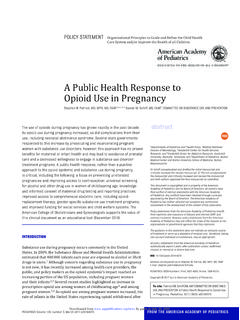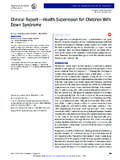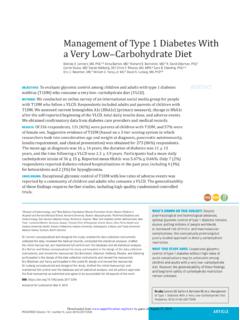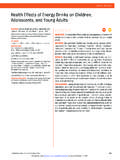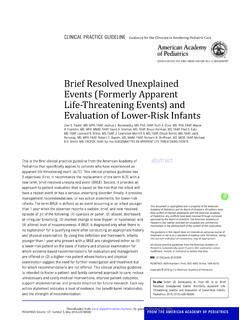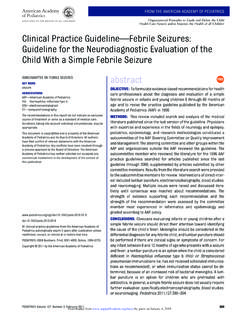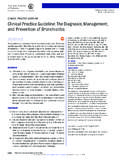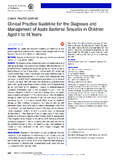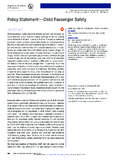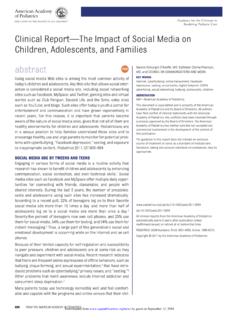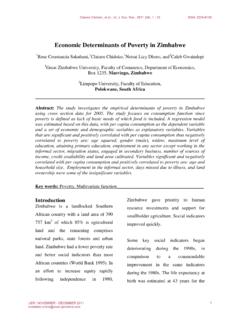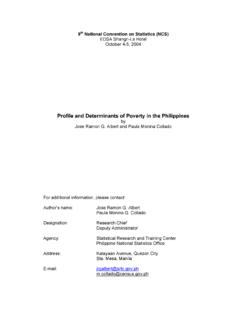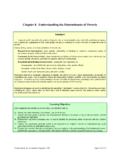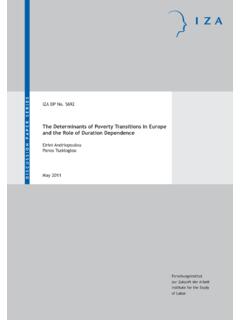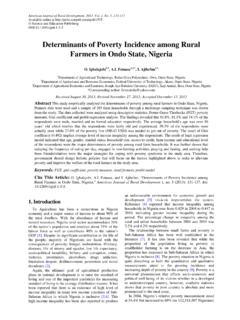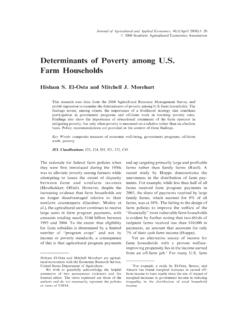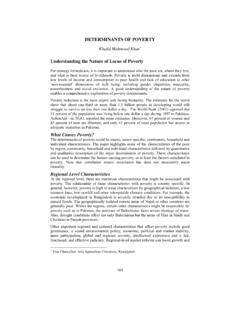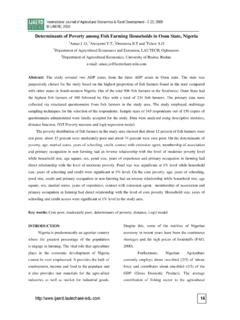Transcription of Social, Economic, and Political Determinants of Child Health
1 social , economic , and Political Determinants of Child HealthNick Spencer, article presents a briefoverview of the effects of social , economic , and politicalfactors on Child Health . It starts by highlighting childpoverty in rich nations, in particular the United Kingdomand the United States, and identifies the economic andpolitical factors underlying this phenomenon. The evi-dence linking socioeconomic status and Child Health isbriefly reviewed with particular attention to birth weightand Child mental Health 2 of the most important publichealth challenges in the 21st century. The implicationsfor pediatricians of high levels of Child poverty and theeffect that these have on children are ;112:704 706; social , economic , Political , childpoverty, OECD, Organization of economic Cooperationand poverty IN RICH NATIONSC hild poverty levels (as measured by percent-age of children in households with 50% ofthe national median income) in the UnitedKingdom ( ) and the United States ( ) areamong the highest in the Organization of EconomicCooperation and Development (OECD) is in sharp contrast to countries such as Sweden,Norway, and Belgium that have Child poverty ratesbelow 5%.
2 1 For example, Sweden reduces marketchild poverty (the Child poverty level before tax andcredit transfers) by as much as 20%, whereas theUnited States, starting from higher market Child pov-erty, reduces it by as little as 5%.There has been a sharp increase in Child povertyrates in the United Kingdom since 1979. The 1980salso saw a rise in Child poverty rates in the UnitedStates. These increases in Child poverty were accom-panied by an increase in income inequalities, a phe-nomenon noted in many industrial countries duringthe past 20 years. Children are now the largest singlegroup living in poverty in many countries. Therealso has been a feminization of poverty lone fe-male parents have very high rates of poverty in allOECD countries, as well as in the United the OECD countries, children in lone-parenthouseholds are 4 times more likely to be living poverty rates are strongly correlated (posi-tive) with the proportion of households in which noadult is employed and the proportion of full-timeworkers earning less than two thirds of the nationalmedian wage.
3 This suggests that countries with highlevels of unemployment among families with chil-dren and low-wage economies are likely to have thehighest rates of Child poverty . The United Kingdom,which has experienced very high levels of unem-ployment in the past 20 years, had 19% of childrenliving in households with no adult employed is important to note that high Child povertyrates are not inevitable. They result from deliberatepolitical decisions, usually related to economic andsocial welfare STATUS AND Child HEALTHG lobally and historically, socioeconomic status isamong the most important Health determinantsthroughout the life children seem tobe particularly vulnerable to the effects of adversesocioeconomic status and poverty . poverty and lowsocioeconomic status are associated with higher riskof death in infancy and childhood, chronic childhoodillness, and many acute are alsoclosely linked with birth weight and Child mentalhealth , increased risk of some adverse healthoutcomes is not confined to the extremes of povertyand low socioeconomic status.
4 Many Child healthoutcomes show a social gradient, although the gra-dient varies by exposure and someoutcomes, the longer the Child is exposed to adversesocial conditions and the worse the social conditions,the greater the weight shows a markedsocial gradient (Table 1). This has profound effectsnot only in infancy and childhood but also into show a graded reduction in mean birthweight as the areas of residence become more de-prived, as measured by the Townsend is not only the most deprived fifth of theinfant population that is disadvantaged in terms ofbirth weight compared with the most privileged the effect is finely graded by socioeconomic findings contribute to our understanding ofthe social gradients that are noted across the Health problems in children also have pro-found effects across the life course.
5 Figure 1 showsthe graded relationship between household incomeand emotional and behavioral problems in childhoodin a recent UK , the effects of incomeFrom the Department of Community Paediatrics, University of Warwick,Conventry, United for publication Mar 14, 2003; accepted Mar 14, correspondence to Thomas Tonniges, MD, FAAP, American Acad-emy of Pediatrics, Department of Community Pediatrics, 141 NorthwestPoint Blvd, Elk Grove Village, IL 60007. E-mail: (ISSN 0031 4005). Copyright 2003 by the American Acad-emy of Vol. 112 No. 3 September 2003 by guest on May 8, from are not confined to the poorest group but have afinely graded distribution across the income and additive risk exposures over timeand between generations may contribute to an un-derstanding of these behaviors,such as smoking, and concepts such as goodenough parenting must be seen within their Social, economic , and Political context.
6 They are risk factorsfor adverse outcomes but exert their effects as part ofcomplex pathways working over time, across gener-ations, and at the societal as well as individual ,13In addition to recognizing the effects of socio- economic status on Child Health , recent studies havedemonstrated that socioeconomic status in earlychildhood has a significant impact on a range ofadult Health FOR PEDIATRICIANSP ediatricians must develop an awareness and un-derstanding of the social Determinants of Health ifthey are to contribute fully to improved Child healthoutcomes. These Determinants have been forgottenin medical education and understated in the contem-porary climate of biomedical and technologic re-sponses to Child illness. I am not suggesting that weshould abandon biomedical and technologic ad-vances.
7 However, we need to see Health within itssocial context to understand the impact of socialfactors on children and on their access and responseto biomedical and technologic advances in also is important that pediatricians be aware ofthe life course implications of early childhood effectsof adverse social circumstances and how thesestretch into adult life. Addressing chronic illness inadult life is likely to require social and Political in-terventions that reduce the adverse effects of socialdisadvantage in childhood. It is equally likely thatinterventions at this level will be required to reducethe prevalence of low birth weight and mental healthproblems in and service structures must seek to over-come the inverse care law, which states that thosemost at risk and most in need of services are the leastlikely to access them.
8 This is a particularly pressingissue in the United States, where many children offamilies with low income have limited access to childhealth services, but it is also a problem in the UnitedKingdom despite the universal availability of high-quality pediatric services. Pediatricians have a spe-cial responsibility for ensuring that children of fam-ilies that are poor or have low income have servicesthat are of equal quality to their more privilegedpeers. Although this may have only a marginal effecton Health outcomes, it can be a vital contribution toensuring that the disadvantage that these childrenalready experience is not exacerbated by lack of ac-cess to poverty is not an unmodifiable situation of families with children can be im-proved, but this will require Political and economicpolicies that are, in essence, redistributive.
9 Highertaxes and/or the redistribution of funds to ensurethat all families with children have an adequate in-come will be necessary to ensure improvements inchild Health (Figs 2 and 3). Given the profound ef-fects of poverty and low income on Health in Child -hood and across the life course, pediatricians andtheir organizations (local and national) have a criticalFig gradient in emotional and be-havioral problems by annual household Gradient in Birth Weight in 2 UK Studies7,8 Enumeration DistrictQuintiles by TownsendDeprivation IndexMean Birth Weight(All Live)W Midlands 1991 1993 Mean Birth Weight(Singleton Only)Sheffield 1991 19931 (least deprived)3393 g (3386, 3400)[n 33 513]3408 g (3376, 3440)[n 3466]23380 g (3372, 3388)[n 31 146]3374 g (3340, 3408)[n 3430]33344 g (3337, 3351)[n 36 542]3319 g (3287, 3351)[n 3372]43293 g (3287, 3299)[n 44 757]3282 g (3248, 3316)[n 3721]5 (most deprived)3219 g (3213, 3226)[n 64 073]3225 g (3190, 3260)
10 [n 3733]SUPPLEMENT705 by guest on May 8, from role to play in advocating for policies that protectchildren from a life in poverty . Advocacy can be atan individual, local, national, or international also have a responsibility to addressthe inverse care law as it applies to research. Theweight of funding and interest in research is concen-trated on rare conditions and their cure, while thesocial Determinants of Health , a major cause of illhealth, receive limited research funding or conducting sociomedical research, we should bearin mind that social factors exert their effects throughcomplex pathways. The single cause fetishism thatarises from the germ theory of disease is inadequateto explain many of the adverse Health outcomes as-sociated with social inequality. Child Health researchmust pay more attention to socioeconomic status andimprove the measures used to study its poverty is increasing in the United Kingdomand the United States.
